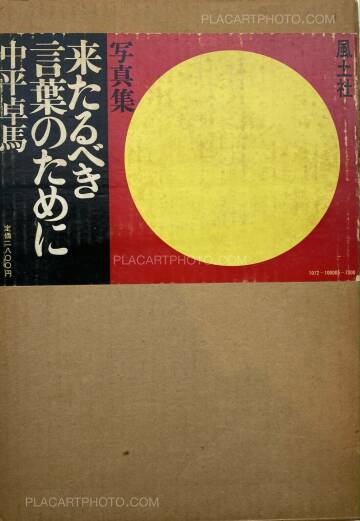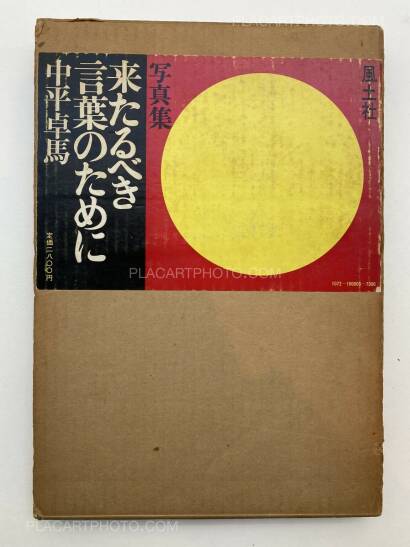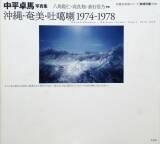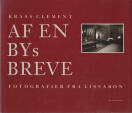For a language to come

Takuma Nakahira
For a language to come
Photographs: Takuma Nakahira
Text: Takuma Nakahira
Publisher: Fudo-sha
192 pages
Pictures: 103
Year: 1970
Comments: Hardcover with jacket and card slipcase, 300 x 212 mm. First edition, 1970. Gravure printing. Included in Martin Parr & Gerry Badger, The Photobook, vol. I, p.292-293 ; Ryuichi Kaneko & Ivan Vartanian, The Japanese Photobooks of the 1960's and 1970's, p.130-133. Very good condition other than a small tear to the spin of the dust jacket. Very scarce.
"Through his photographs and writings Takuma Nakahira was both the chief polemicist for the Provoke group and its political conscience. Along with Moriyama's Sashin yo Sayonara (Bye Bye Photography), his book Kitarubeki Kotoba no Tameni (For a language to come) marks the apogee of the Provoke period. It exhibits all the characteristics of the Provoke style - an unabashed revelling in "bad" photographic technique, the mannerisms of the New York School pushed to the edge of coherence. These qualities would tend to make the casual reader bracket it with Moriyama's masterpiece, yet a closer look at Nakahira's book reveals that Nakahira's sensibility is quite different. Althoug the more political of the two, Nakahira didt not photograph "political" subjects directly, but utilized a troubled lyricism to express his disaffection with the colonization of Japan by American consumerism. Whereas Moriyama is jumpy and frenetic in tone, Nakahira displays a brooding calm. For a language to come closes with several shots of the sea, and the book's narrative is punctured at intervals with marine images. Far from suggesting boundless space, this is a dark, bleak and menacing sea, with the consistency of soup, a metaphor for claustrophobia and a narrowing of horizons.
The other overwhelming metaphor in the book is fire, an apocalyptic, post-Hiroshima conflagration, often expressed indirectly in Nakahira's night pictures with swathes of burned-out lens flare. These "natural" metaphors - water and fire - remind us that this is essentially a "landscape" book, though a landscape of the mind. The two, however, are inextricably related (...). These are sad, beautiful pictures of half-light - and half-life. They are quintessential Provoke images, and stand for much postwar Japanese photography prior to the 1980s."
Martin Parr & Gerry Badger, The Photobook: A History, vol.I















more books by Takuma Nakahira
-
Okinawa, Amami, Tokara 1974-1978
by Takuma Nakahira
sold -
Overflow
by Takuma Nakahira
sold -
Degree Zero - Yokohama
by Takuma Nakahira
sold -
OKINAWA (LTD EDT)
by Takuma Nakahira
Euro 90 -
Aratanaru gyoushi / New Gaze
by Takuma Nakahira
sold
more books tagged »Takuma Nakahira« | >> see all
-
Provoke 4 & 5: First Abandon the World of Pseudo-Certainty
by Provoke group
sold -
PROVOKE MAGAZINES (BACK IN STOCK)
by Collective
Euro 100 -
Provoke : Between Protest and Performance : Photography in Jap...
by Provoke group
sold -
Provoke (First edition)
by Provoke group
price on request -
A Battlefield in the city
by Collective
sold -
Provoke 2 (First edition)
by Provoke group
price on request
more books tagged »japanese photobook« | >> see all
-
Adam and Eve (Signed)
by Nobuyuki Wakabayashi
Euro 1200 -
Tokyo
by Sohei Nishino
sold -
Our Pocketkamera 1985 (SIGNED)
by Seiichi Furuya
sold -
Ryusei hanabi
by Collective
sold -
Tokyo 2016-2017
by Michio Yamauchi
Euro 40 -
E-HON (picture book) SIGNED
by Shuntaro Tanikawa
sold
more books tagged »seventies« | >> see all
-
De Openstaande vrouw (Woman Ajar)
by Marcel Mariën
sold -
Andy Warhol - The Stockholm catalogue (THIRD EDT)
by Andy Warhol
sold -
A DIALOGUE WITH SOLITUDE (SIGNED)
by Dave Heath
sold -
Terror in New York (with obi)
by Mickey Yasukawa
Euro 250 -
Eigijin vol.1
by Collective
price on request -
ONLY YESTERDAY (SIGNED)
by Kazuyuki Kawaguchi
sold
more books tagged »provoke« | >> see all
-
Provoke : Between Protest and Performance : Photography in Jap...
by Provoke group
sold -
Toshi Ha Yume Mizu (City Doesn't Dream)
by Yutaka Takanashi
sold -
The Japanese Box
by Collective
sold -
Farewell Photography
by Daido Moriyama
sold -
Provoke (Set of 3 vol. +1) 1968-1969
by Provoke group
price on request -
Guevara Shashin Shu Che
by Light of Buenos
sold
more books tagged »japanese« | >> see all
-
A Criminal Investigation (First edition)
by Yukichi Watabe
sold -
Structure pulsion (ONLY 40 COPIES WITH 7 PRINTS)
by Takashi Homma
sold -
HOTARU(FIREFLY) (SIGNED)
by Yoshio Mizoguchi
sold -
Jpeg (Signed)
by Naoki Kajitani
sold -
Ikonta story (ASSOCIATION COPY WITH OBI)
by Nobuyoshi Araki
sold -
Nippon Gekijo Shashincho (SIGNED)
by Daido Moriyama
Euro 1500
Books from the Virtual Bookshelf josefchladek.com




































;jpg)
;jpg)
_-_guevara_shashinshu_-_che_(ゲバラ写真集_チェ_ブエノスの灯_編_年現代書館発行);jpg)

;jpg)
;jpg)
 Facebook
Facebook Instagram
Instagram